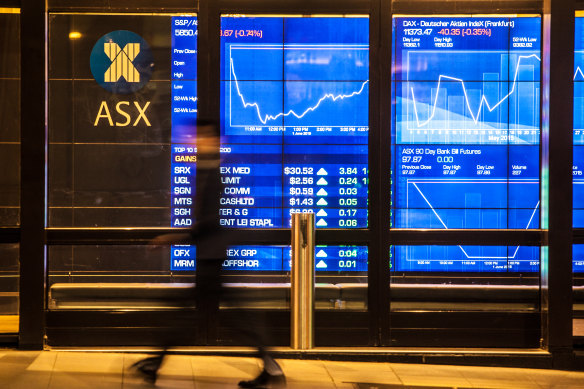Australian shares expected to open higher
By Koh Gui Qing
The Australian share market is expected to open higher as investors shrug off the most recent set of minutes from the US Federal Reserve that indicated interest rates would stay higher for longer.
ASX futures were pointing to a jump of 110.5 points, or 1.6 per cent, to 7,003.5 at 8.45am.
Global stocks and bonds closed higher on Wednesday on cautious optimism about the new year after a brutal 2022, although US stocks eased off session highs after the Federal Reserve released minutes from its December meeting that struck a hawkish note.

The MSCI All-World index added 0.65 per cent, receding from earlier highs and in tandem with US stocks, which pulled back after the Fed’s minutes showed it was worried about any market “misperception” that its commitment to fighting inflation was flagging.
Describing the minutes as “modestly hawkish”, analysts at Citi said they expect the Fed to raise rates by 50 basis points in February, and for US rates to peak between 5.25 per cent and 5.5 per cent. US rates stand at 4.25 per cent to 4.5 per cent currently.
“Fed officials are clearly growing more uncomfortable with the market underpricing their likely policy path and may use more hawkish rhetoric to drive front-end rates higher and financial conditions tighter,” the analysts at Citi said.
US stocks still ended up on the day. The S&P 500 climbed 0.75 per cent, the Dow Jones Industrial Average rose 0.4 per cent, and the Nasdaq Composite climbed 0.7 per cent.
Data released on Wednesday showed US job openings falling less than expected on the last day of November, indicating a still-tight labour market that could allow Fed to keep rates higher for longer.
The yield on 10-year US Treasury notes fell to 3.679 per cent, and 2-year Treasury yields, which typically move in step with interest rate expectations, slipped to 4.3534 per cent.
The modest recovery in stocks and bonds showed optimism about two factors that made 2022 a hellish year for investors: the constant drumbeat of rate hikes to fight inflation and China’s economy-throttling anti-COVID measures.
But investors in other assets were jittery. Oil prices fell sharply, as concerns about global demand persisted amid signs of weakening activity in the main engines of global growth: the United States, Europe and China.
“Fresh warnings about the effect of aggressive rate hikes on the US economy are rattling traders again, with the oil price continuing its march downwards,” said Susannah Streeter, senior investment and markets analyst at Hargreaves Lansdown.
US crude fell 4.85 per cent to $US73.2 per barrel, while Brent was at $US78.07, down 4.9 per cent on the day.
“The market has made a pretty tentative start to the year … (and) is still grappling with the notion of what we are going to see from the Fed this year,” said Rob Carnell, head of ING’s Asia-Pacific research.
“There are two camps out there and they are wrestling for dominance in terms of the view. Some days higher-for-longer wins, some days (the) higher-then-lower camp wins,” Carnell said.
Hopes for less aggressive rate hikes boosted non-yielding gold, with spot prices for the precious metal hitting $US1,856.57 per ounce, their highest since mid-June.
The dollar index, which measures the greenback against six other currencies, fell 0.45 per cent as commodities currencies like the Australian dollar gained and the euro rose on the positive French and German inflation data.
Sterling was last trading at $US1.20575, up 0.75 per cent, while the euro rose 0.54 per cent to $US1.06050, coming off a three-week low of $US1.0519 touched overnight.
The Japanese yen softened against the dollar at 132.500 per dollar.
– with a staff reporter
Most Viewed in Business
Source: Thanks smh.com